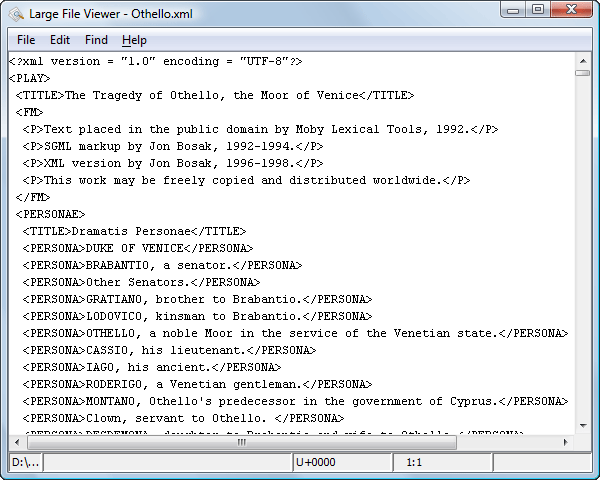Large File Viewer
XML files tend to become larger and larger mostly because they are frequently used as a format for database export or for porting between multiple database formats. Traditional XML text editors simply cannot handle opening these huge export files, some having sizes exceeding one gigabyte, because all of the file content must be loaded in memory before the user can actually view it.
The best performance of the viewer is obtained for encodings that use a fixed number of bytes per character (such as UTF-16 or ASCII). The performance for UTF-8 is very good for documents that use mostly characters of the European languages. For the same encoding, the rendering performance is higher for files consisting of long lines (up to few thousands characters) and may degrade for short lines. In fact, the maximum size of a file that can be rendered in the Large File Viewer decreases when the total number of the text lines of the file increases. Trying to open a very large file (for example, a file of 4 GB) with a very high number of short lines (100 or 200 characters per line) may produce an out of memory error (OutOfMemoryError) that would require either increasing the Java heap memory with the -Xmx startup parameter or decreasing the total number of lines in the file.
The powerful Large File Viewer is available from the Tools menu or as a standalone application. You can also right-click a file in your project and choose to open it with the viewer. It uses an efficient structure for indexing the open document. No information from the file is stored in the main memory, just a list of indexes in the file. In this way the viewer can open very large files, up to 10 gigabytes. If the open file is XML, the encoding used to display the text is detected from the XML prolog of the file. For other file types, the encoding is taken from the Oxygen XML Editor options. See Encoding for non-XML files.

Large File Viewer components:
-
The menu bar provides menu driven access to all the features and functions that are available in Large File Viewer:
- Opens files in the viewer (also available in the contextual menu).
- Closes the viewer.
- Copies the selected text to clipboard (also available in the contextual menu).
- Opens a reduced Find dialog box that provides some basic
search options, such as:
- Case sensitive - When selected, operations are case-sensitive.
- Regular Expression - When selected, allows you to use any regular expression in Perl-like syntax.
- Wrap around - Continues the find operation from the start/end of the document after reaching the end/, depending on whether the search is in forward or backward direction.
- Provides access to the User Manual.
- The status bar provides information about the current file path, the Unicode representation of the character at the cursor position and the line and column in the open document where the cursor is located.
